The Montonero guerrillas that terrorised Argentina between 1972 and 1979 were some of the most imaginative, best organized, and best funded revolutionaries in modern history. The majority of the Montoneros were not from the poor underprivileged classes, but rather from the upwardly mobile middle class, a class whose aspirations were frustrated by multiple political and economic factors.
As so many young people did throughout Latin America, they turned to the romantic image of the Cuban revolution of 1959 as a model to be emulated. This spawned two major groups in Argentina the People's Revolutionary Army (ERP) and the Montonero's. While the ERP were the more militarily competent of the two groups, the Montoneros had a flair for spectacular operations with high political impact.
One of the factors behind this ability was 60 million dollars that the Montoneros had acquired in a high profile kidnapping in 1975. The money was received in exchange for the release of Juan and Jorge Born, two national owners of an Argentine wheat and agriculture multi-national corporation. This money gave the Montoneros the ability to finance elaborate schemes and plans.
For example, the Montoneros were able to set up an arms manufacturing "plant" (a series of shops scattered all over Argentina) that manufactured high quality weapons, particularly explosives, grenades, rifle grenades, grenade launchers and submachineguns. They also were able to dedicate time to the development and printing of highly sophisticated military manuals and regulations to include the creation of regulations for uniforms.
While operational conditions did not allow Montonero units to strictly adhere to the uniform regulations, Montonero guerrillas did wear "uniforms" during most of their major operations from 1975 on, that generally adhered to the spirit of the published regulations.
Regulations
The regulations were as follows: All Montonero members, whether militias or combatants were to wear navy blue slacks, and a sky blue long sleeve shirt with epaulettes. This was topped by a black beret. The jacket was to be of black leather with four patch pockets. All shoes, belts and equipment pouches were to be in black leather.
Insignia were as follows: A national roundel, was to be worn on the beret consisting of sky blue circles on a white background. Gold metal branch insignia were to be worn on the collar, crossed lances over a cog wheel for the militias and a lance crossed with a rifle for the combatants. Special forces were to wear a black and red shield on the left breast pocket of the jacket.
Rank insignia were cut out of cloth and sewn affixed to a square navy blue background, also made of cloth. The rank insignia structure was as follows: combatants wore one no rank. Sergeants wore one thin gold chevron over two thick . A sub-lieutenant wore one gold circle. A lieutenant wore two one gold circle above one white circle. A captain wore two white circles. A major wore three white circles in a vertical line. A superior officer wore two gold circles, and a guerrilla commander wore one red circle.
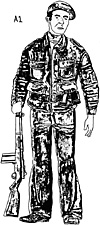 On the jacket, rank was worn in the middle of the left sleeve only, while on the shirt,
they were worn on the left breast. The only difference between the arm and breast
insignia was that for the sergeant rank shirt insignia chevrons were replaced by
horizontal bars.
On the jacket, rank was worn in the middle of the left sleeve only, while on the shirt,
they were worn on the left breast. The only difference between the arm and breast
insignia was that for the sergeant rank shirt insignia chevrons were replaced by
horizontal bars.
This figure at right shows a sergeant of the special forces in almost complete regulation dress. The only deviation is his navy blue pullover in place of the regulation sky blue shirt. His weapons consist of a Belgian made SAFN-49, probably of Venezuelan origin that has been modified to accept the FN FAL 20 round magazine. The SAFN-49 was the predecessor to the FAL. The two grenades on his belt are of Montonero manufacture, the larger of the two designed to be fired from a rifle grenade cup attachment.
 The collar insignia of the militias and the combat units at left. The insignia are crossed
to form a V rather than an X, the V for Vive Peron, or Peron Lives.
The collar insignia of the militias and the combat units at left. The insignia are crossed
to form a V rather than an X, the V for Vive Peron, or Peron Lives.
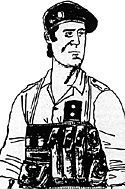 At right, Montonero lieutenant wearing the regulation shirt and beret. On his chest is a
pouch made from commercial turquoise canvas cloth for a submachinegun user. It has
three pouches for submachinegun magazines plus a variety of other pouches and
places to put other equipment and hang grenades.
At right, Montonero lieutenant wearing the regulation shirt and beret. On his chest is a
pouch made from commercial turquoise canvas cloth for a submachinegun user. It has
three pouches for submachinegun magazines plus a variety of other pouches and
places to put other equipment and hang grenades.
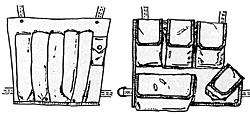 At left are two further variants of this type of chest rig. The first is for Montonero
made rifle grenades. The small pouch on the end is to carry .22 calibre blanks for the
Montonero made LGF-22 grenade launcher. Next to this is a variant of the chest pouch
for an FN FAL rifle. The colour of this turquoise cloth varied from dark to very light. All
of the strap s were made in a tan canvas with double red piping. Next to our lieutenant
is a variant of the beret and the beret insignia consisting of an eight sided red
Montonero star with the combat units collar insignia in black with a black M above the
crossed lance and rifle.
At left are two further variants of this type of chest rig. The first is for Montonero
made rifle grenades. The small pouch on the end is to carry .22 calibre blanks for the
Montonero made LGF-22 grenade launcher. Next to this is a variant of the chest pouch
for an FN FAL rifle. The colour of this turquoise cloth varied from dark to very light. All
of the strap s were made in a tan canvas with double red piping. Next to our lieutenant
is a variant of the beret and the beret insignia consisting of an eight sided red
Montonero star with the combat units collar insignia in black with a black M above the
crossed lance and rifle.
 The chest rank insignia (out of order).
The chest rank insignia (out of order).
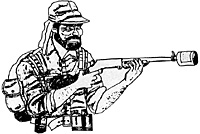 A Montonero guerrilla in Tucuman 1975. The ERP had a mountain company in
Tucuman that was virtually wiped out by the army in the only rural campaign of the war.
As ERP numbers dwindled, the Montoneros sent a number of reinforcements wearing
blue uniforms, described by army officers who fought them as looking like Argentine
police uniforms. One officer said that the uniforms made splendid targets and that many
of the guerrillas that wore these uniforms were quickly killed. His weapon is a commercial
shotgun with a grenade discharging cup attached to the barrel. Different Montonero
made grenades for this type of cup launcher are attached to his belt.
A Montonero guerrilla in Tucuman 1975. The ERP had a mountain company in
Tucuman that was virtually wiped out by the army in the only rural campaign of the war.
As ERP numbers dwindled, the Montoneros sent a number of reinforcements wearing
blue uniforms, described by army officers who fought them as looking like Argentine
police uniforms. One officer said that the uniforms made splendid targets and that many
of the guerrillas that wore these uniforms were quickly killed. His weapon is a commercial
shotgun with a grenade discharging cup attached to the barrel. Different Montonero
made grenades for this type of cup launcher are attached to his belt.
2. C. A Montonero during an attack on the Monte Chingolo arsenal, December, 1975.
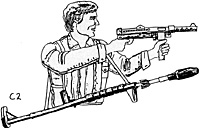 Although mostly an ERP operation, the Montoneros participated wearing a uniform of denim jeans and jackets. This Montonero carries an LGF-22 over his chest, all ready with an anti-tank rifle grenade ready for launching. Meantime he wields a Montonero made copy of the Carl Gustav 9mm submachinegun. Although this weapon is difficult to manufacture, the Montonero copy was nearly as good as the Swedish made version, although somewhat cruder.
Although mostly an ERP operation, the Montoneros participated wearing a uniform of denim jeans and jackets. This Montonero carries an LGF-22 over his chest, all ready with an anti-tank rifle grenade ready for launching. Meantime he wields a Montonero made copy of the Carl Gustav 9mm submachinegun. Although this weapon is difficult to manufacture, the Montonero copy was nearly as good as the Swedish made version, although somewhat cruder.
The plans for this weapon came from Chilean terrorists who had fled their country in 1973, after the military coup. The weapon was standard issue with the Chilean police known as Carabineros. The Chilean terrorists had made a manufacturing study of the weapon before the military coup in September 1973, and had actually manufactured some extremely crude copies of this weapon before they were forced out of the country.
Eventually the plans reached Argentina where the Montoneros began to mass produce them. However, only a few of these weapons reached the hands of the guerrillas as the factory was raided in 1976 by the military where over 500 unfinished guns were captured. Military officers who tested the Montonero made weapon said it was very reliable and accurate.
Back to Table of Contents -- El Dorado Vol VII No. 4
© Copyright 1997 by The South and Central Military Historians Society
This article appears in MagWeb (Magazine Web) on the Internet World Wide Web.
Other military history articles and gaming articles are available at http://www.magweb.com